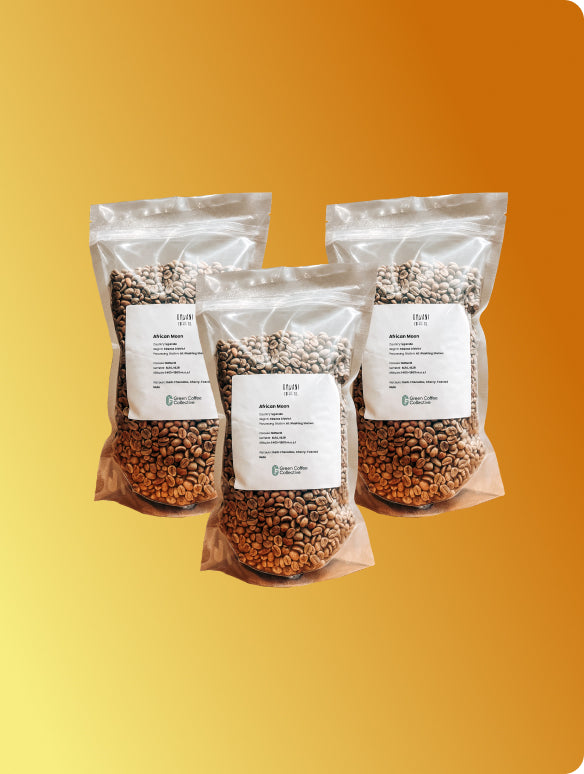Not everyone can drink caffeine, making decaf coffee an integral product for coffee roasters to consider. Recent research and development in decaf coffee have led to new breakthroughs. Successful roasters need to stay up to date on decaf products to optimise their roasting facilities.
This guide provides a breakdown of how decaffeinated coffee is made and highlights the unique challenges and techniques involved in roasting decaf coffee for the best flavour.
What is Decaf Coffee?
Caffeine is a chemical substance found in coffee, known for its stimulating effects. In its pure form, caffeine is an odourless white crystalline powder with a bitter taste. Arabica coffee varietals have lower caffeine content compared to robusta varietals.
Is Decaf Completely Decaffeinated?
For coffee to be classed as decaffeinated, it must have a significant reduction in caffeine. While there is no established worldwide percentage, in the EU, decaf coffee must have between 0.1 wt% - 0.3 wt% caffeine by weight. Although it is nearly impossible to remove all caffeine, EU regulations ensure that decaf coffee has negligible levels of caffeine.
Why is Decaf Coffee Cheaper?
The decaffeination process can result in the loss of essential oils and flavours in the coffee bean. Typically, lower-grade coffee is used for decaf because higher-grade coffee is reserved for products where these oils are crucial. Generally, decaf consumers have been a neglected group, but this is changing. High-grade coffee producers, roasters, and sellers are now more conscious about creating the best coffee for caffeine-sensitive customers. While decaf is generally cheaper than regular coffee, the market for high-grade decaf is growing, offering higher-quality options.
How Do You Decaffeinate Coffee?
There are two main methods for decaffeinating coffee: chemical and organic. Both methods involve hydrating the green coffee beans and using a solvent to extract the caffeine.
Common decaf solvents include:
- DCM (Dichloromethane)
- EA (Ethyl Acetate)
- scCO2 (Supercritical Carbon Dioxide)
- LiCO2 (Liquid Carbon Dioxide)
- Water
The hydrated beans are treated with the chosen solvent, which penetrates the beans to draw out the caffeine. After extraction, the beans are dried to restore their initial water content. This process is typically carried out at processing stations, requiring industrial-sized plants for large quantities.
Due to the treatment required, some side effects are unavoidable:
- Loss of aroma
- Change in bean structure
- Change in size
- Change in appearance
- Loss of mass
- Solvent residue
Ideally, the decaffeination process removes caffeine without altering other bean characteristics. Newer methods, like the Swiss Water Process, aim to mitigate these unwanted changes.
Chemical Decaf vs. Organic Decaf
Both chemical and organic categories of decaffeination process have their own sub-groups.
Chemical Decaf Methods:
- Direct Solvent: Beans are steamed to release caffeine and open pores, then rinsed in a chemical (methylene chloride or ethyl acetate) for up to 10 hours. This method, including the sugarcane decaf process, is popular among many roasters.
- Indirect Solvent: Beans are soaked in hot water to extract caffeine, which is then treated with a solvent. The solvent consumes the caffeine, leaving oils and flavor molecules in the water. The beans are reintroduced to the water to reabsorb these components.
Organic Decaf Methods:
- Swiss Water Process: Beans are hydrated, and a green coffee extract (GCE) circulates around the beans for 8-10 hours to remove caffeine. The GCE is then filtered to remove caffeine and can be reused.
- Carbon Dioxide Process: Beans are soaked and placed in a steel container with liquid CO2, which extracts caffeine under pressure. The CO2 is then converted back to gas, leaving caffeine residue and preserving the beans' essential components.
Is Decaf Coffee Safe to Drink?
Due to the presence of chemicals in certain decaf methods, customers may be worried about any potential risks.
A good example is methylene chloride. This solvent removes the caffeine particles from the coffee. However, it is banned in many other products. Even though almost all chemical residue is destroyed during the roasting phase, there still may be traces of unwanted solvents in chemical decaf processes.
To mitigate these risks, EU laws have been put in place to limit the amount of certain chemical solvents:
|
Chemical Solvent for decaffeination |
Maximum residue limits in extracted coffee |
|
Methyl acetate |
20 mg/kg in coffee |
|
Ethylmethylketone |
20 mg/kg in coffee |
|
Dichloromethane |
2 mg/kg in roasted coffee |
Does Decaf Taste Different?
Decaf coffee can lose some natural flavours during the decaffeination process. Chemical methods may impart slight artificial flavours, while organic methods preserve more natural taste. The roasting process plays a crucial role in maintaining the flavor profile of decaf coffee.
How to Roast Decaf Coffee
For roasters really looking to get the most out of their decaffeinated beans, they will need to bear in mind the fact that these beans will be slightly different than untreated, caffeinated coffee. This is because the methods used for caffeine extraction will alter the structure of the coffee beans.
A much more careful, gentle roast is required to make sure that the decaf coffee retains its flavours. This is because decaf coffee is more susceptible to scorching and risks losing its flavour while being roasted.
Tips for Roasting Decaf Coffee:
- Use a lower charge temperature to avoid burning.
- Monitor temperature closely before the first crack.
- Adjust roasting recipes for each decaffeination method.
- Consider the unique properties of decaf beans for optimal results.
Is Decaf Darker Than Regular Coffee?
Decaf coffee is naturally lighter in colour before roasting but darkens faster during roasting. Roasters should focus on mass loss rather than color to ensure quality. Organic decaf methods like the Swiss Water Process result in darker coffee with better internal quality indicators.

